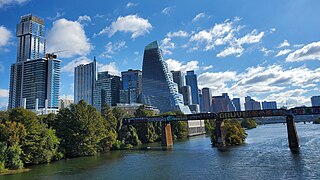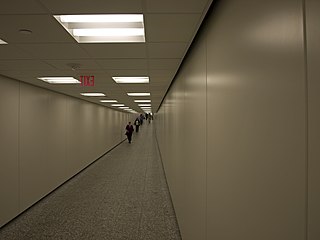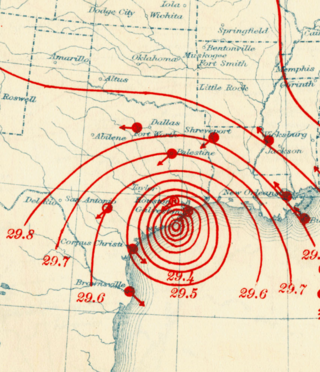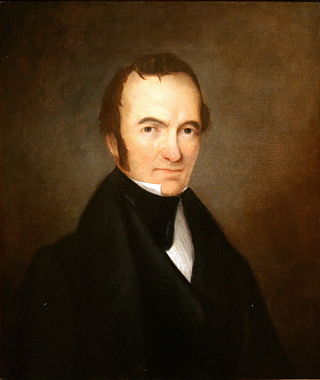
Austin is the capital of the U.S. state of Texas, as well as the seat and most populous city of Travis County, with portions extending into Hays and Williamson counties. Incorporated on December 27, 1839, it is the 11th-most populous city in the United States, the fourth-most populous city in the state after Dallas, San Antonio and Houston, and the second-most populous state capital city after Phoenix, the capital of Arizona. It has been one of the fastest growing large cities in the United States since 2010. Downtown Austin and Downtown San Antonio are approximately 80 miles (129 km) apart, and both fall along the Interstate 35 corridor. This combined metropolitan region of San Antonio–Austin has approximately 5 million people. Austin is the southernmost state capital in the contiguous United States and is considered a Gamma-level global city as categorized by the Globalization and World Cities Research Network.
KVUE is a television station in Austin, Texas, United States, affiliated with ABC and owned by Tegna Inc. The station's studios are located on Steck Avenue just east of Loop 1 in northwest Austin, and its transmitter is located on the West Austin Antenna Farm northwest of downtown.

The Houston tunnel system is a network of subterranean, climate-controlled, pedestrian walkways that links 95 full city blocks 20 feet (6 m) below Houston's downtown streets. It is approximately six miles (9.7 km) long. There are similar systems in Chicago, Dallas, Oklahoma City, Montreal, and Toronto. Architectural historian Stephen Fox has stated that the idea for the tunnel system came when the Bank of the Southwest Building was "linked by tunnel to the 1010 Garage and the Mellie Esperson Building" in 1961.
The Capital Metropolitan Transportation Authority, officially stylized as CapMetro, is a public transportation provider located in Austin, Texas. It operates bus, paratransit services and a hybrid rail system known as CapMetro Rail in Austin and several suburbs in Travis and Williamson counties. In 2023, the system had a ridership of 25,229,400, or about 81,500 per weekday as of the fourth quarter of 2023.

The 1915 Galveston hurricane was a tropical cyclone that caused extensive damage in the Galveston area in August 1915. Widespread damage was also documented throughout its path across the Caribbean Sea and the interior of the United States. Due to similarities in strength and trajectory, the storm drew comparisons with the deadly 1900 Galveston hurricane. While the newly completed Galveston Seawall mitigated a similar-scale disaster for Galveston, numerous fatalities occurred along unprotected stretches of the Texas coast due to the storm's 16.2 ft (4.9 m) storm surge. Overall, the major hurricane inflicted at least $30 million in damage and killed 403–405 people. A demographic normalization of landfalling storms suggested that an equivalent storm in 2005 would cause $68.0 billion in damage in the United States.

The Frost Bank Tower is a skyscraper in Austin, Texas, United States. Standing 515 feet (157 m) tall with 33 floors, it is the fifth tallest building in Austin, behind The Independent, The Austonian, Fairmont Austin, and the 360 Condominiums. It was developed by Cousins Properties from November 2001 to December 2003 as a class A office building with 525,000 sq ft (48,774 m2) of leasable space. It was the first high-rise building to be constructed in the United States after the 9/11 attacks. The building was officially dedicated in January 2004.

Barton Creek Square is an enclosed shopping mall located in southwest Austin, Texas in the United States, near the intersection of Texas State Highway Loop 1 and Texas State Highway Loop 360. The mall is eponymously named after Barton Creek, Texas. Anchor stores are Dillard's, JCPenney, Macy's, and Nordstrom.

After declaring its independence from Mexico in March, 1836, the Republic of Texas had numerous locations as its seat of government. This being seen as a problem attempts were made to select a permanent site for the capital. January, 1839, with Mirabeau B. Lamar as the newly elected president, a site selection commission of five commissioners was formed. Edward Burleson had surveyed the planned townsite of Waterloo, near the mouth of Shoal Creek on the Colorado River, in 1838; it was incorporated January 1839. By April of that year the site selection commission had selected Waterloo to be the new capital. A bill previously passed by Congress in May, 1838, specified that any site selected as the new capital would be named Austin, after the late Stephen F. Austin; hence Waterloo upon selection as the capital was renamed Austin. The first lots in Austin went on sale August 1839.

Downtown Austin is the central business district of Austin, Texas, United States. The area of the district is bound by Lamar Boulevard to the west, Martin Luther King Jr. Boulevard to the north, Interstate 35 to the east, and Lady Bird Lake to the south.

Shoal Creek is a stream and an urban watershed in Austin, Texas, United States.

The Capitol View Corridors are a series of legal restrictions on construction in Austin, Texas, aimed at preserving protected views of the Texas State Capitol from various points around the city. First established by the Texas Legislature in 1983 and recodified in 2001, the corridors are meant to protect the capitol dome from obstruction by high-rise buildings. While supported by cultural and historical preservation organizations, the corridors have also been criticized for limiting the potential for the development of new tall structures in downtown Austin.

Block 185 is an office skyscraper located at 601 W. 2nd St. in Downtown Austin, Texas. The tower topped out in July 2021. The tower is the fourth tallest in Austin at 594 feet, and the tallest office tower in Texas outside of Houston or Dallas. Block 185 is bound to the west by Shoal Creek, to the east by Nueces Street, to the north by Second Street and to the south by Cesar Chavez Street. The tower is located on the final parcel of the former Green Water Treatment Plant and in Austin's Second Street District.

Fifth & West Residences is a 39-story residential skyscraper located at 501 West Ave. in Downtown Austin, Texas. The tower is the twelfth tallest in Austin at 459 feet (140 m). Fifth & West is the fourth tallest all-residential tower in Austin, behind The Independent, The Austonian and 360 Condominiums. The building is located along a Capitol View Corridor, creating a unique triangular tower atop a square podium base. The tower is located in the Shoal Creek floodplain.

The West Fifth Street Bridge is a historic cantilever concrete girder bridge in downtown Austin, Texas. Built in 1931, the bridge carries Fifth Street across Shoal Creek to link central Austin with neighborhoods that were then the city's western suburbs. It is one of only a handful of curved cantilever girder bridges in Texas, built as part of the city's 1928 master plan for urban development and beautification. The bridge was added to the National Register of Historic Places in 2019.

The 1839 Austin city plan is the original city plan for the development of Austin, Texas, which established the grid plan for what is now downtown Austin. It was commissioned in 1839 by the government of the Republic of Texas and developed by Edwin Waller, a Texian revolutionary and politician who would later become Austin's first mayor.

Colonel Monroe Martin Shipe, also called M. M. Shipe, was an American real estate developer who developed Hyde Park, an early streetcar suburb in Austin, Texas. He also founded the Austin Electric Railway Company, a streetcar network that initially served Hyde Park but expanded to become the public transit network for the city of Austin and, eventually, the direct predecessor of Austin's current transit agency, Capital Metropolitan Transportation Authority.

The Third Street Railroad Trestle is a historic wooden railroad trestle bridge crossing Shoal Creek in downtown Austin, Texas. Built around 1922 by the International–Great Northern Railroad, it replaced an earlier bridge in the same place. The bridge was used by the I–GN Railroad, the Missouri Pacific Railroad, and the Missouri–Kansas–Texas Railroad until 1964, when commercial rail traffic stopped; after 1991 the bridge was abandoned. It was added to the National Register of Historic Places in 2021.
The Downtown Transit Tunnel was a planned light rail tunnel in Downtown Austin, Texas. It was a core feature of the proposed initial investment of Project Connect, the transit expansion plan being undertaken by the Capital Metropolitan Transportation Authority. The transit tunnel would have served the Orange, Blue, and (eventually) Gold light rail lines. The tunnel was eventually cut from Project Connect plans after unexpected cost increases and design challenges.

Sixth and Guadalupe is an under construction 66-story mixed-use skyscraper in Downtown Austin, Texas. On November 2, 2022, the building celebrated its topping out, making it the tallest building in Austin, surpassing The Independent, and the sixth tallest building in Texas. The tower is expected to be completed in summer 2024.
















